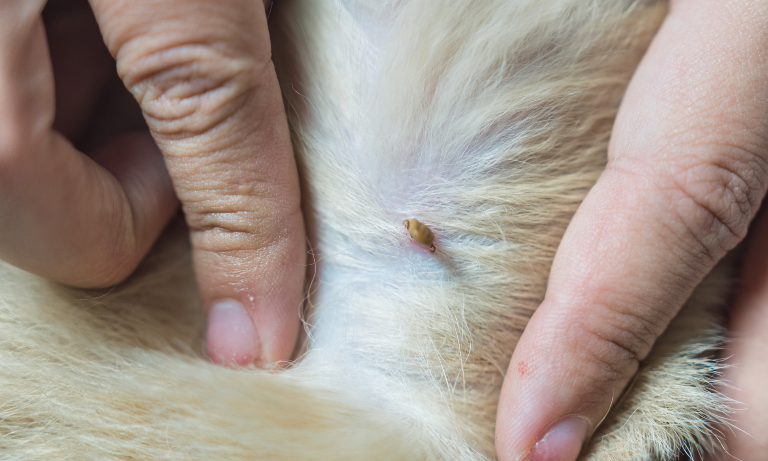Standing up for the veterinary profession
08 Aug 2024
26 Mar 2025 | Anna Judson
BVA Senior Vice President Anna Judson looks at how pet owners can identify, remove, and prevent ticks, to make sure their pet stays healthy and safe.

As temperatures start to rise, ticks in the UK become more active, posing a risk to our pets. We urge pet owners to remain vigilant, understand the risks associated with ticks, and know how to protect their pets safely and effectively. Here’s our handy guide to help:
Identifying ticks on your pet
Ticks are small, dark, oval-shaped parasites that can be difficult to spot, especially in pets with thick or dark fur, sometimes being mistaken for a small wart or growth. They latch onto your pet’s skin and feed on their blood. It’s often only when they’re bigger, swollen with blood, that they are noticed. Common areas where ticks attach include around the ears, neck, legs and between the toes as these are the areas in regular contact with vegetation. Regularly inspecting these areas is essential, especially after your pet has been outdoors in areas known for high tick populations.
Checking your pet for ticks
To thoroughly check your pet for ticks, carefully part your pet’s fur, focusing on the areas mentioned above. Use your hands to feel for small lumps or bumps on your pet’s skin as ticks can sometimes be felt more easily than seen.
Safely removing ticks
If you find a tick on your pet, it’s important to remove it promptly with one of the readily available tick removing tools which are designed for safe and complete tick removal. These reduce the risk of tick-borne disease transfer by minimising the risk of a tick expelling blood back into the pet during its removal and the chance of skin infections from tick mouthparts being left behind in your pet’s skin.
Follow the tick remover tool instructions. The most common technique involves sliding the end of the tool under the tick and then, using a twisting motion, gently and slowly lifting the tick off the pet. Wear gloves and avoid contact with any blood released during tick removal. After removing the tick, clean the bite area with a pet appropriate antiseptic and wash your hands.
If you think part of the tick might have been left behind, don’t worry. In many cases this won’t be a problem. However, if the area becomes swollen, sore or is bothering the pet, you should seek veterinary attention.
Understanding the risks: tick-borne disease
While the overall risk of tick-borne disease in pets in the UK is low, it’s not negligible. One example is Lyme disease, caused by the bacterium Borrelia burgdorferi, which some ticks can carry. Symptoms in pets may include fever, lethargy, swollen joints, and loss of appetite. Another tick-borne disease is Babesiosis, caused by a microscopic parasite that lives in red blood cells and can cause anaemia and lethargy. If you notice any of these symptoms, which can be similar to those from other infections, contact your vet.
If you are thinking of taking your pet abroad, speak with your vet for advice in plenty of time before travelling. Some countries have additional tick species to those we have here and a greater variety of tick-borne diseases. If you do travel with your pet, don’t forget to be vigilant and thoroughly check your pet and your vehicle for ticks before you return home to avoid inadvertently bringing unwanted parasite passengers back which could impact UK pets more widely if they become established in the UK.
Preventing tick infestations
Prevention is the best strategy against ticks. If you can, avoid walking your pet in high-risk areas such as grassland, woodland and heathland during peak tick activity times of the year. You can also speak with your vet to discuss whether a tick control product might be needed based on your pet’s lifestyle, health status, and tick prevalence in your area.
Follow your vet practice team’s advice on how to safely and correctly apply and dispose of the products and any additional instructions such as avoiding bathing your pet or letting it swim in ponds or rivers for a duration after use. Parasite control products are valuable tools supporting animal health and welfare, but we should use them with care to minimise any environmental impact from their use.
Get tailored news in your inbox and online, plus access to our journals, resources and support services, join the BVA.
Join Us Today